Range Rover Evoque: Manual Transmission FWD
Component Location
COMPONENT LOCATION
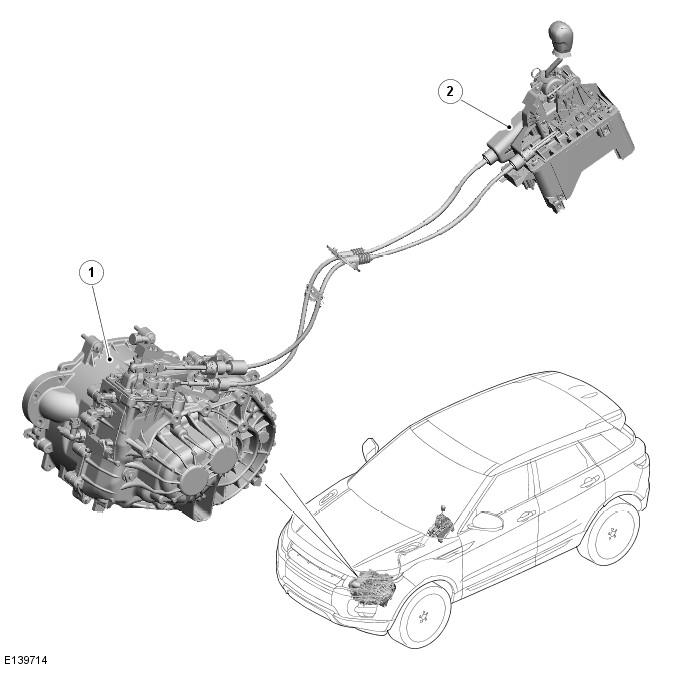
- Manual transmission
- Selector lever assembly
Overview
OVERVIEW
The M66EH50 manual transmission is a 6 speed unit manufactured by Getrag-Ford in Cologne, Germany. The transmission is a highly compact 4 shaft design, incorporating the front final drive gear. The transmission is capable of transferring high torque from the engine.
The transmission features two mechanical shift cables from the selector lever and an electronic reverse inhibitor.
The M66EH50 manual transmission has the following features:
- 380 Nm torque capacity (with torque truncation in 1st and reverse gears)
- Dry weight 61 kg
- Transmission oil is fill for life
- Front differential integral with transmission
- 6 forward gears
- 4th to 6th gears and reverse gear have single cone synchronization
- 3rd gear is double cone synchronized
- 1st and 2nd gears have triple cone synchronization.
The clutch system used is a conventional type, with a single stage damped driven plate and a diaphragm spring clutch cover assembly. The clutch is hydraulically operated by operation of the clutch pedal which disengages the drive from the engine crankshaft to the transmission.
System Operation and Component Description
System Operation
OPERATION
Transmission Gear Cluster
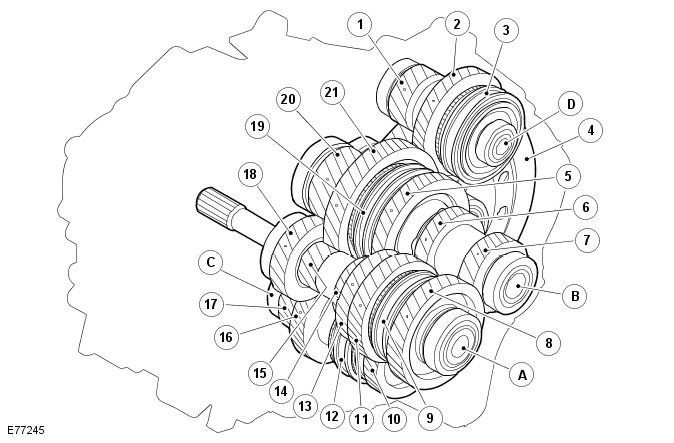
- Input shaft
- Intermediate shaft 1st to 2nd, 5th to 6th
- Intermediate shaft 3rd to 4th
- Reverse shaft
- Reverse final gear
- Reverse idler gear
- Reverse gear coupling sleeve
- Final gear - differential
- 2nd gear - idle gear
- 5th gear
- 6th gear
- 6th gear - idle gear
- 5th to 6th gear coupling sleeve
- 4th gear - idle gear
- 5th gear - idle gear
- 3rd to 4th gear coupling sleeve
- 4th gear
- 2nd gear path
- 1st gear path
- 3rd gear - idle gear
- 3rd to 4th final gear pinion
- 3rd gear
- 1st to 2nd gear coupling sleeve
- 1st to 2nd and 5th to 6th final gear pinion
- 1st gear - idle gear
The gear wheels are located on four shafts, as follows:
- Input shaft
- Intermediate shaft 1-2, 5-6
- Intermediate shaft 3-4
- Reverse shaft.
In order to keep the shafts short, the clutch gears are welded directly to the idler wheel and needle bearings with inner rings are used instead of snap rings. The inner rings sit on the shaft inside the idler gears and extend lengthwise outside each idler gear. When the components on the shafts are pulled together the inner rings counterhold, so that the idler wheels have the clearance that they require to rotate. The components of the input shafts are pulled together with a bolt located in the end of the shaft. Components of intermediate shaft 3rd -4th are held together with a press joint and a bolt located in the end of the shaft. The components of intermediate shaft 1st -2nd, 5th -6th are held together with the press joint of the 5th and 6th gear pinion.
1st Gear Power Flow
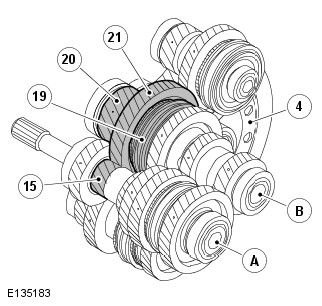
- Input shaft
- Intermediate shaft 1st - 2nd and 5th - 6th
- Ring gear
- 1st gear
- 1st - 2nd gear coupling sleeve
- Final drive 1st - 2nd and 5th - 6th
- 1st gear idler gear
When 1st gear is selected, the coupling sleeve for 1st - 2nd gear is moved by a gear selector fork along the synchronizing hub towards the 1st gear idler gear. The coupling sleeve and the synchronizing hub lock the 1st gear idler gear at the intermediate shaft 1st - 2nd and 5th - 6th.
Engine torque is transferred to the input shaft via the clutch. The 1st gear rack on the input shaft transfers the power to the 1st gear idler gear. From there the power is transferred to the intermediate shaft 1st - 2nd and 5th - 6th and to the final drive, which in turn transfers power to the ring gear. The ring gear is connected to the drive shafts through the differential.
2nd Gear Power Flow
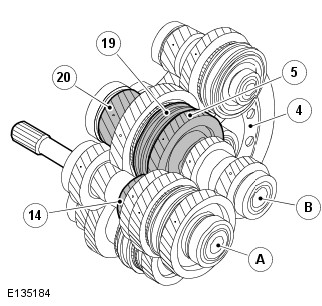
- Input shaft
- Intermediate shaft 1st - 2nd and 5th -
- Ring gear
- 2nd gear idler gear
- 2nd gear
- 1st - 2nd gear coupling sleeve
- Final drive 1st - 2nd and 5th - 6th
When 2nd gear is selected, the coupling sleeve for 1st - 2nd gear is moved by a gear selector fork along the synchronizing hub towards the 2nd gear idler gear. The coupling sleeve and the synchronizing hub lock the 2nd gear idler gear at the intermediate shaft 1st - 2nd and 5th - 6th.
Engine torque is transferred to the input shaft via the clutch. The 2nd gear rack on the input shaft transfers the power to the 2nd gear idler gear. From there the power is transferred to the intermediate shaft 1st - 2nd and 5th - 6th and to the final drive, which in turn transfers power to the ring gear. The ring gear is connected to the drive shafts through the differential.
3rd Gear Power Flow
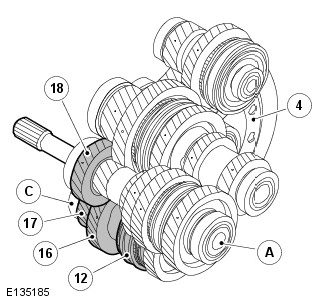
- Input shaft
- Intermediate shaft 3rd - 4th
- Ring gear
- 3rd - 4th gear coupling sleeve
- 3rd gear idler gear
- Final drive 3rd - 4th
- 3rd gear
When 3rd gear is selected, the coupling sleeve for 3rd - 4th gear is moved by a gear selector fork along the synchronizing hub towards the 3rd gear idler gear. The coupling sleeve and the synchronizing hub lock the 3rd gear idler gear at the intermediate shaft 3rd - 4th.
Engine torque is transferred to the input shaft via the clutch. The 3rd gear rack on the input shaft transfers the power to the 3rd gear idler gear. From there the power is transferred to the intermediate shaft 3rd - 4th and to the final drive, which in turn transfers power to the ring gear. The ring gear is connected to the drive shafts through the differential.
4th Gear Power Flow
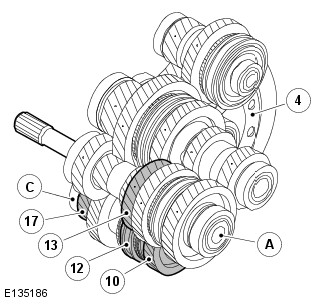
- Input shaft
- Intermediate shaft 3rd - 4th
- Ring gear
- 4th gear idler gear
- 3rd - 4th gear coupling sleeve
- 4th gear
- Final drive 3rd - 4th
When 4th gear is selected, the coupling sleeve for 3rd - 4th gear is moved by a gear selector fork along the synchronizing hub towards the 4th gear idler gear. The coupling sleeve and the synchronizing hub lock the 4th gear idler gear at the intermediate shaft 3rd - 4th.
Engine torque is transferred to the input shaft via the clutch. The 4th gear rack on the input shaft transfers the power to the 4th gear idler gear. From there the power is transferred to the intermediate shaft 3rd - 4th and to the final drive, which in turn transfers power to the ring gear. The ring gear is connected to the drive shafts through the differential.
5th Gear Power Flow
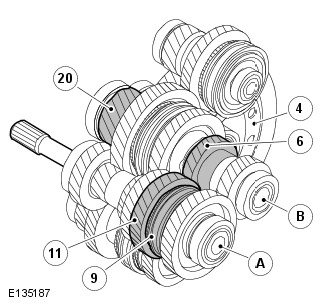
- Input shaft
- Intermediate shaft 1st - 2nd and 5th - 6th
- Ring gear
- 5th gear
- 5th - 6th gear coupling sleeve
- 5th gear idler gear
- Final drive 1st - 2nd and 5th - 6th
When 5th gear is selected, the coupling sleeve for 5th - 6th gear is moved by a gear selector fork along the synchronizing hub towards the 5th gear idler gear. The coupling sleeve and the synchronizing hub lock the 5th gear idler gear at the input shaft.
Engine torque is transferred to the input shaft via the clutch. The 5th - 6th coupling sleeve and 5th gear idler gear located on the input shaft, transfer the power to the 5th gear. From there the power is transferred to the intermediate shaft 1st - 2nd and 5th - 6th and to the final drive, which in turn transfers power to the ring gear. The ring gear is connected to the drive shafts through the differential.
6th Gear Power Flow
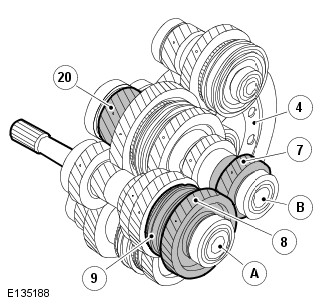
- Input shaft
- Intermediate shaft 1st - 2nd and 5th - 6th
- Ring gear
- 6th gear
- 6th gear idler gear
- 5th - 6th gear coupling sleeve
- Final drive 1st - 2nd and 5th - 6th
When 6th gear is selected, the coupling sleeve for 5th - 6th gear is moved by a gear selector fork along the synchronizing hub towards the 6th gear idler gear. The coupling sleeve and the synchronizing hub lock the 6th gear idler gear at the input shaft.
Engine torque is transferred to the input shaft via the clutch. The 5th - 6th coupling sleeve and 6th gear idler gear located on the input shaft, transfer the power to the 6th gear. From there the power is transferred to the intermediate shaft 1st - 2nd and 5th - 6th and to the final drive, which in turn transfers power to the ring gear. The ring gear is connected to the drive shafts through the differential.
Reverse Gear Power Flow
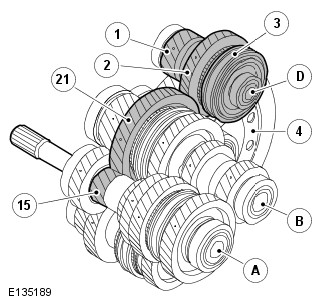
- Input shaft
- Intermediate shaft 1st - 2nd and 5th - 6th
- Reverse shaft
- Final drive for reverse gear
- Reverse gear idler gear
- Reverse gear coupling sleeve
- Ring gear
- 1st gear
- 1st gear idler gear
When reverse gear is selected, the coupling sleeve for reverse gear is moved by a gear selector fork along the synchronizing hub towards the reverse gear idler gear.
The coupling sleeve and synchronizing hub lock the reverse gear idler gear at the reverse shaft.
The torque of the engine is transferred via the clutch to the input shaft. The 1st gear on the input shaft transfers power to the 1st gear idler gear. The power is then transferred to the reverse gear idler gear and then to the reverse gear coupling sleeve. From there power is transferred to the intermediate shaft 1st - 2nd and 5th - 6th and to the final drive which in turn transfers power to the ring gear. The ring gear is connected to the drive shafts through the differential.
Differential
The differential distributes drive from the transmission equally between the LH (left-hand) and RH (right-hand) front half shafts.
The differential is located at the rear of the transmission housing. Both sides of the differential are connected to the LH and RH drive shafts, supplying torque to the front wheels.
Reverse Switch
The reverse switch is located in the front of the transmission casing, above the 1st gear position switch. The switch is used for reversing lamp operation.
1st Gear Position Switch
The 1st gear switch is located on the front of the transmission casing, below the reverse switch. The switch is not used on FWD (front wheel drive) vehicles.
Neutral Gear Sensor
A permanent magnet, linear contactless displacement sensor is located on the exterior of the transmission casing and hardwired to the ECM (engine control module). The sensor's function is to detect that neutral gear has been selected within a calibrated window.
Component Description
DESCRIPTION
For shift cable and selector lever description refer to External Controls.
Refer to: External Controls (308-06 Manual Transmission/Transaxle External Controls, Description and Operation).
Transmission
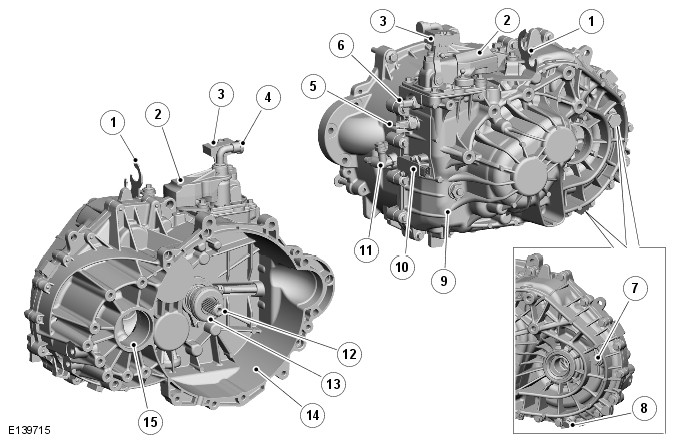
- Cable retaining bracket
- Longitudinal lever
- Lateral lever
- Breather
- 1st gear detection switch
- Reverse detection switch
- Transmission oil level/filler plug
- Transmission drain plug
- Transmission casing
- Neutral gear sensor
- Hydraulic clutch bleed adaptor
- Input shaft
- Clutch slave cylinder
- Clutch housing
- Differential output (RH side)
Shift Control Mechanism
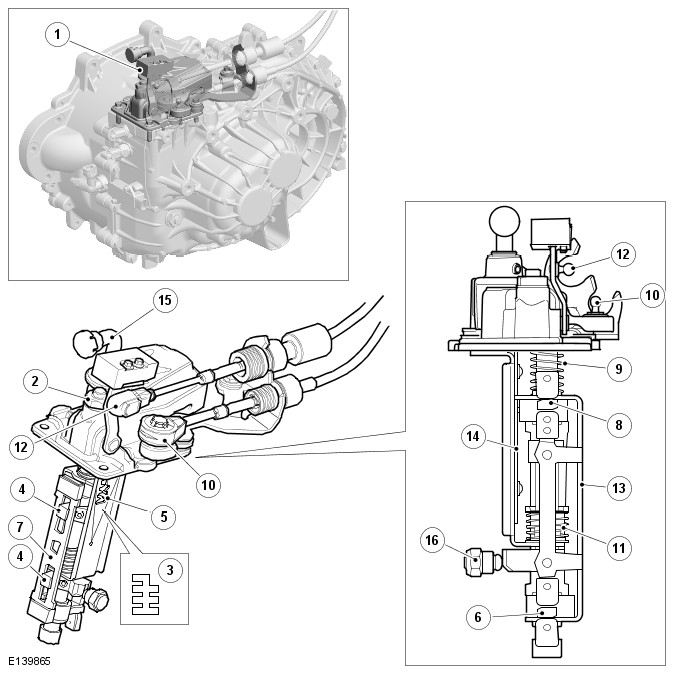
- Shift control mechanism
- Ball limiter 5th - 6th gear control
- Gearshift gate
- Flange
- Gear shift gate pin
- Lower gear selector
- Gear selector rod
- Upper gear selector
- Spring
- Longitudinal lever
- Spring
- Lateral lever
- Catch plate
- Carrier plate
- Breather
- Ball limiter for gear selector
The transmission is operated by two shift cables which are attached to the selector lever. Movement of the selector lever is passed via the cables to two lever mechanisms on the top of the transmission. The levers operate a shift control mechanism within the transmission to select the requested gear ratio.
The shift control mechanism is located at the front of the transmission and transfers the shift cable movement into gear selections.
The shift control mechanism is a one-piece assembly which is retained in the transmission housing with 4 bolts. The shift control mechanism moves the upper and lower gear selector forks via the lateral and longitudinal levers on the top of the shift control mechanism. There are 2 upper selector forks and 2 lower selector forks as follows:
- The 2 upper gear selector forks are used to engage reverse, 1st or 2nd gears
- The 2 lower gear selector forks are used to engage 3rd, 4th, 5th and 6th gears.
The 4 selector forks transfer movement from the shift control mechanism to the relevant shift coupling sleeve. The shift forks are mounted in bearings in the transmission case.
Two carrier plates transfer torque from the longitudinal lever to the sliding gear selectors. The carriers are located and run in a groove in the gear selector plate.
The carrier plates can move vertically between 4 positions. The different gears are selected from one of the 4 positions as follows:
- Uppermost position - gear selector selects reverse gear
- Second uppermost position - gear selector selects 1st and 2nd gears
- Second lowest position - gear selector selects 5th and 6th gears
- Lowest position - gear selector selects 3rd and 4th gears.
The shift control mechanism has two springs that return the selector lever to the neutral position.
Transmission Shift Selector Shafts
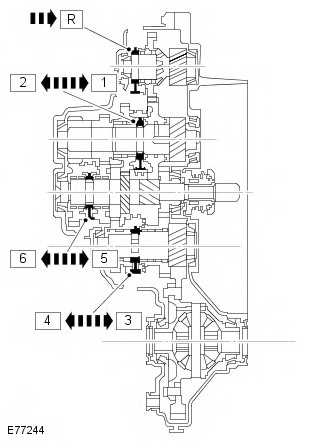
The above illustration shows the coupling sleeves for each gear cluster. Movement of these sleeves as selected by the shift control mechanism, connect the required gear trains together to produce the required output ratio.
The coupling sleeve is part of the synchronizing hub assembly which also consists of a flange and the hub. Each synchronizing hub is joined to its shaft by splines and rotates with it. Idler wheels are fitted on both sides of each synchronizing hub. The idler wheels rotate freely on the shaft (with the exception of reverse gear). Each idler wheel is constantly engaged in its pinion. The synchronizing set is positioned between the synchronizing hub and the idler wheel.
The synchronizing units are positioned on the shafts in the transmission as follows:
- The synchronizing unit for 1st - 2nd gear is on the intermediate shaft 1st - 2nd, 5th - 6th
- The synchronizing unit for 3rd - 4th gear is on the intermediate shaft 3rd - 4th
- The synchronizing unit for 5th-6th gear is on the input shaft
- The synchronizing unit for reverse gear is on the reverse shaft.
The synchronizing rings expand when heated by the same amount as the components they are in contact with. As a result no safety margin is required to counter expansion. The idler wheels for single and double synchronization have no cones.
An inner ring on the synchronizer unit performs this function instead.

